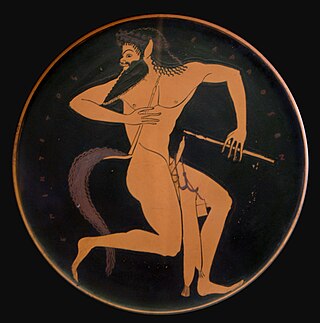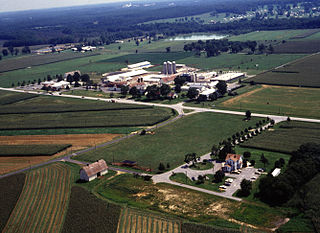
According to urban legend, Goatman is a creature resembling a goat-human hybrid often credited with canine deaths and purported to take refuge in the woods of Prince George's County, Maryland, United States. [1] [2]

According to urban legend, Goatman is a creature resembling a goat-human hybrid often credited with canine deaths and purported to take refuge in the woods of Prince George's County, Maryland, United States. [1] [2]
In May of 1971, University of Maryland student George Lizama completed an undergraduate folklore project on the Goatman that was later added to the Maryland Folklife Archives. In Lizama’s paper, the Goatman was said to be located on Tucker Road in Clinton, Maryland. Later the same year, reporter Karen Hosler discovered Lizama’s project in the Maryland Folklife Archives and reported on it in the Prince George’s County News in October 1971, this time placing the Goatman near Fletchertown Road in Bowie, Maryland. Additionally, this report covered the theory that the Goatman’s origins can be traced to the Beltsville Agricultural Research Center. [2]
While Goatman stories originated in the early 1970s, some of its legends are set in the late 1930s, within Prince George's County, following the disappearances and/or deaths of multiple dogs, which were later attributed to the creature. However, given the condition of the remains, the deaths may more likely have been the result of passing trains. [1] Despite evidence to the contrary, stories of Goatman's existence continued to circulate, especially among local students. Graffiti reading, "Goatman was here," were not uncommon, [3] and law enforcement would habitually receive calls of reported sightings, albeit with a number being pranks. [1]
The creature was commonly claimed to have a human face but with a body covered in hair. However, descriptions differed on whether Goatman greatly resembled a hairy humanoid or a human with the lower portion of a goat, similar to the fauns of Greek mythology. [1] [3]
As well, Goatman was rumored to reside in a makeshift shelter in the wooded region of northeastern Prince George's County near the abandoned trailer parks. Occasionally, it was rumored that Goatman would venture out to kill any living thing such as animals, humans, etc . [1]

According to some variations of the legend, Goatman is said to have once been a scientist, Dr. Stephen Fletcher, who worked in the Beltsville Agricultural Research Center. [4] In this version, an experiment on goats backfires and the scientist mutates into a half man, half goat creature who begins aggressively attacking cars in the vicinity of Beltsville, Maryland. Another variation of the legend holds that Goatman himself was an old hermit who lived in the woods and often could be seen walking alone at night along Fletchertown Road. [5]
According to University of Maryland folklorist Barry Pearson, the Goatman legend began "long, long, long" ago and were further popularized in 1971 when the death of a dog was blamed on Goatman by local residents. Pearson relates that "bored teenagers" keep the Goatman legend alive by repeating the story and suggesting that the creature attacks couples, frequenting the local lover's lane, subsequently stirring interest in sites like Fletchertown Road. [6] [7]

In Greek mythology, a satyr, also known as a silenus or silenos, and sileni (plural), is a male nature spirit with ears and a tail resembling those of a horse, as well as a permanent, exaggerated erection. Early artistic representations sometimes include horse-like legs, but, by the sixth century BC, they were more often represented with human legs. Comically hideous, they have mane-like hair, bestial faces, and snub noses and they always are shown naked. Satyrs were characterized by their ribaldry and were known as lovers of wine, music, dancing, and women. They were companions of the god Dionysus and were believed to inhabit remote locales, such as woodlands, mountains, and pastures. They often attempted to seduce or rape nymphs and mortal women alike, usually with little success. They are sometimes shown masturbating or engaging in bestiality.

Beltsville is a census-designated place (CDP) in northern Prince George's County, Maryland, United States. The community was named for Truman Belt, a local landowner. The 2020 census counted 20,133 residents. Beltsville includes the unincorporated community of Vansville.

In South Jersey and Philadelphia folklore in the United States, the Jersey Devil, also known as the Leeds Devil, is a legendary creature said to inhabit the forests of the Pine Barrens in South Jersey. The creature is often described as a flying biped with hooves, but there are many variations. The common description is that of a bipedal kangaroo-like or wyvern-like creature with a horse- or goat-like head, leathery bat-like wings, horns, small arms with clawed hands, legs with cloven hooves, and a forked or pointed tail. It is also said that it has a strange elongated body and a thick tail. It has been reported to move quickly and is often described as emitting a high-pitched "blood-curdling scream".
Goatman or Goat man may refer to:

The Pope Lick Monster is a legendary part-man, part-goat and part-sheep creature reported to live beneath a railroad trestle bridge over Pope Lick Creek, in the Fisherville neighborhood of Louisville, Kentucky, United States.
In American folklore, the snallygaster is a bird-reptile chimera originating in the superstitions of early German immigrants later combined with sensationalistic newspaper reports of the monster. Early sightings associate the snallygaster with Frederick County, Maryland, especially the areas of South Mountain and the Middletown Valley. Later reports would expand on sightings encompassing an area to include Central Maryland and the Washington, DC, metro area.
In Texan folklore, the Lake Worth Monster is a legendary creature said to inhabit Lake Worth at the Fort Worth Nature Center and Refuge, just outside Fort Worth. The creature is often described as a "part-man, part-goat" with scales and long clawed fingers.
Crybaby Bridge is a term that refers to numerous bridges across the United States, associated with urban legends and ghost stories involving the sounds of a baby crying. These tales typically involve tragic backstories of infanticide, accidents, or other sorrowful events that purportedly occurred at or near the bridges, for example, an urban legend relating to a baby or young child/children where the mother threw her baby off the bridge and felt so bad that she killed herself. She now looks for her baby while crying in the river sadly. The phenomenon is not limited to a specific location, but represents a type of folklore that has become embedded in the cultural fabric of various regions, each adapting the legend to fit local histories or landscapes.
The glaistig is a ghost from Scottish mythology, a type of fuath. It is also known as maighdean uaine, and may appear as a woman of beauty or monstrous mien, as a half-woman and half-goat similar to a faun or satyr, or in the shape of a goat. The lower goat half of her hybrid form is usually disguised by a long, flowing green robe or dress, and the woman often appears grey with long yellow hair.

The Henry A. Wallace Beltsville Agricultural Research Center (BARC), also known as the National Agricultural Research Center, is a unit of the United States Department of Agriculture's Agricultural Research Service. It is located in unincorporated Prince George's County, Maryland, with sections within the Beltsville census-designated place. The BARC is named for Henry A. Wallace, former United States vice president and secretary of agriculture. BARC houses the Abraham Lincoln Building of the National Agricultural Library.

Old Alton Bridge, also known as Goatman's Bridge, is a historic iron truss bridge connecting the Texas cities of Denton and Copper Canyon. Built in 1884 by the King Iron Bridge Manufacturing Company, it originally carried horses and later automobiles over Hickory Creek at a location that once was a popular ford for crossing cattle. The bridge takes its name from the abandoned community of Alton, which between 1850 and 1856 was the seat of Denton County. This bridge is the subject of several ghostlore stories featuring a vengeful ghost.
Mythic humanoids are legendary, folkloric, or mythological creatures that are part human, or that resemble humans through appearance or character. Each culture has different mythical creatures that come from many different origins, and many of these creatures are humanoids. They are often able to talk and in many stories they guide the hero on their journey.

Maryland Route 212 is a state highway in the U.S. state of Maryland. The highway runs 10.43 miles (16.79 km) from the District of Columbia boundary in Chillum north and east to U.S. Route 1 near Beltsville. MD 212 connects the northern Prince George's County communities of Chillum, Langley Park, Adelphi, Hillandale, Calverton, and Beltsville. The highway was constructed from Washington, D.C. to Adelphi in the early 1910s and extended north through Adelphi to Hillandale in the early 1930s. A separate portion of MD 212 was built from west of US 1 through Beltsville to what is now MD 201 in the early 1930s; the two sections were unified in the early 1940s. The route was expanded to a divided highway south of Langley Park in the early 1960s and at Interstate 95 (I-95) in the early 1970s. MD 212's eastern terminus was relocated north of Beltsville after a series of county highways were upgraded and brought into the state highway system in the 2000s and early 2010s; the old highway through Beltsville to MD 201 became MD 212A.

Mothman, in West Virginian folklore, is a humanoid creature reportedly seen in the Point Pleasant area from November 15, 1966, to December 15, 1967. The first newspaper report was published in the Point Pleasant Register, dated November 16, 1966, titled "Couples See Man-Sized Bird ... Creature ... Something". The national press soon picked up the reports and helped spread the story across the United States. The source of the legend is believed to have originated from sightings of out-of-migration sandhill cranes or herons.

The Beltsville Speedway, formerly the Baltimore-Washington Speedway was an asphalt oval track in Prince George's County, Maryland; it spanned 0.500 miles (0.805 km).
{{cite book}}: CS1 maint: location missing publisher (link)